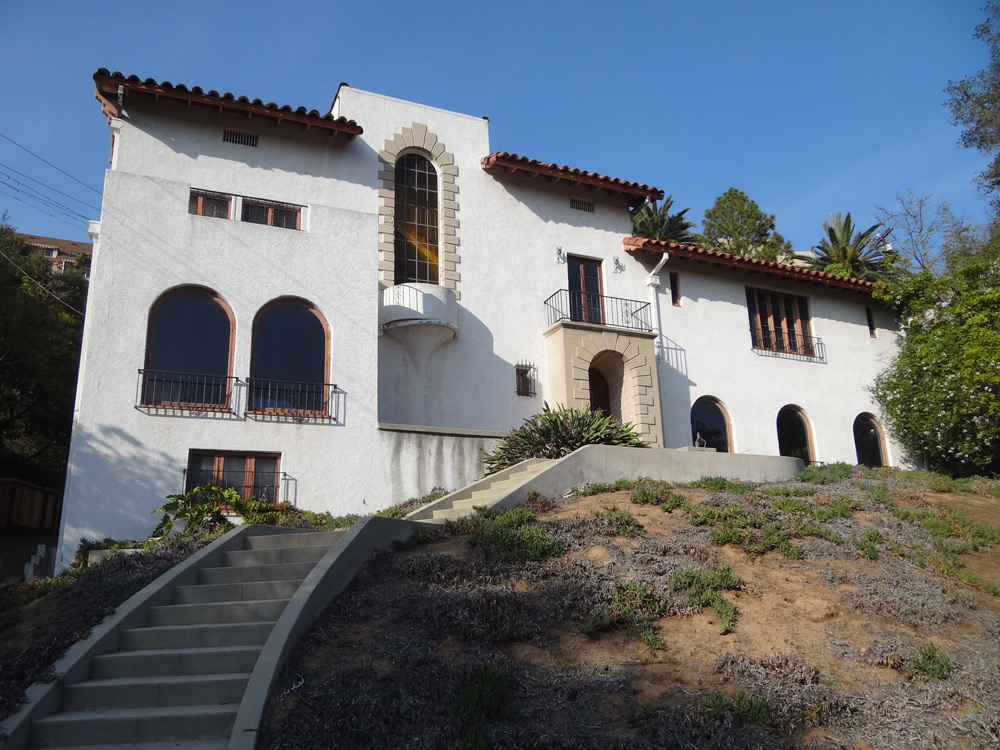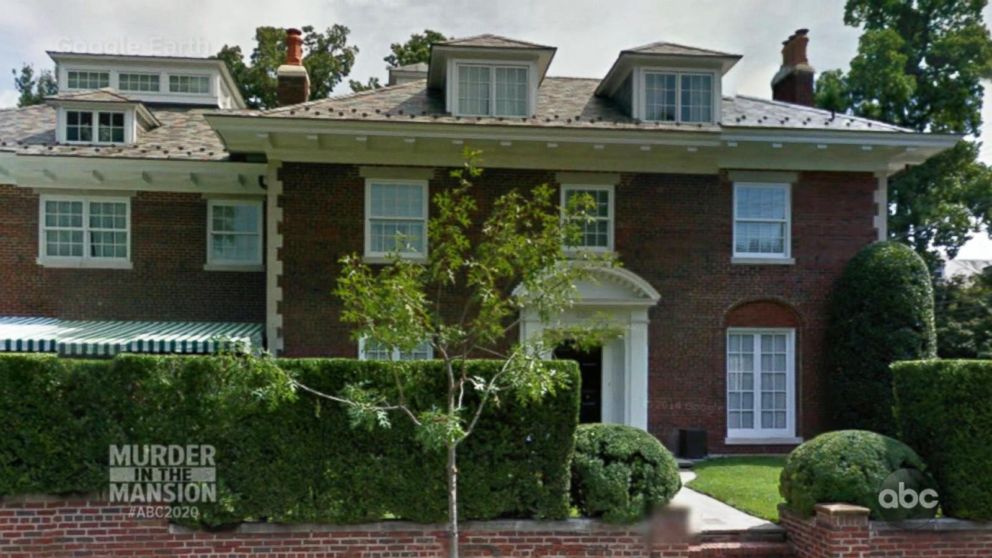Three people, a couple and a young woman, get lost in a vicious fog and seek protection from the elements in an ancient, ghostly mansion. John Bush, Rovi. AHS: Murder House also takes inspiration from one of the most famous murder houses in United States history: the Amityville manor. Like in the show, the Amityville manor was a house steeped in evil. In 1974, it was the scene of a brutal murder by 23-year-old Ronald J. DeFeo Jr., who shot his parents and four siblings as they slept.
Article on the Perelson murder-suicide published in The Los Angeles Times on December 7, 1959
Many neighborhoods have at least one creepy house that has inspired ghost stories. That house in Los Feliz, located at 2475 Glendower Place, was the “Murder Mansion.” It received the ominous moniker because it was the scene of a horrific murder-suicide in December of 1959. Although the mansion was sold a year after those horrific events, the estate remained vacant and slowly deteriorated on the inside and outside.
For a long time the “Murder Mansion” was a dark tourist attraction. Trespassers constantly trekked up to the derelict estate to peer into the windows to catch a glimpse of the dust covered furniture, peeling paint, and maybe a ghost. In an article for LA Weekly, Brian Clune described some of the paranormal activity ghost hunters claimed to have witnessed at the “Murder Mansion”1:
“The [ghost] hunters have reported hearing the sound of a woman calling out “No!” in a terrified voice, followed by her frantic screaming and then silence. This silence is then shortly followed by the low moan of a male, who sounds as if he is in distress; this moaning goes on for a short while until all is again silent…
“The [ghost] hunters tell of seeing the face of a woman staring at them through one of the upstairs windows; she will gaze at them for a few minutes and then simply vanish from sight. Many have photographed this apparition, but when they got home and downloaded the photos onto their computers or got their film developed, she was not in any of the frames…”1

It’s possible all of those inexplicable experiences may have been imagined, inspired by property’s rundown appearance and the terrible crimes that took place there.

The Spanish-revival residence is located on a hillside in Los Feliz, a posh neighborhood in Los Angeles. It was built by Harry S. Schumacher in 1925 and designed by architect Harry E. Weiner. The three-story home had four master bedrooms, three bedrooms, a library, a ballroom with a bar, a three-car garage, terraced lawns, and manicured gardens.2 After Schumacher died in 1932, the property switched hands a few times until the Perelson family moved in sometime in the 1950’s.
Advertisement of 2475 Glendower auction published soon after Schumacher death in 1932. Published in the Los Angeles Times in 1932.
Dr. Harold Perelson purchased the 5000-square-foot house as a home for him, his wife Lillian, and their three children (Judye, Joel, and Debbie). Dr. Perelson was a prominent heart surgeon affiliated with a clinic in Inglewood, a professor of cardiology at the USC School of Medicine, and authored a number of authoritative research articles in medical journals.3,4 By 1959, fifty-year-old Harold Perelson was a successful heart surgeon who had a beautiful family with no outward signs of conflict.
When the lights were extinguished in the Perelson home on December 6, 1959, darkness descended on the family in more ways than one.
Early the next morning around 5am, 18-year-old Judye woke up to a throbbing headache. Her head was bleeding and she saw her father standing over her with a ball-peen hammer in his hand.
Judye screamed and fought Harold off with all of her strength. When she finally broke free, the wounded teenager staggered downstairs and out of the house to a neighbor’s home.
The two youngest children, 13-year-old Joel (sometimes referred to as Joseph) and 11-year-old Debbie, woke up when Debbie screamed. When Harold saw that his youngest children were awake, he told them to, “Go back to bed. This is a nightmare.” Fortunately, Debbie and Joel did not listen and ran out of the house unharmed.5
Judye stumbled next door to the home of Marshall Ross, who called the police. Although she survived the attack, she was sent to the hospital by ambulance and treated for skull fractures.
According to a 1959 article in the Los Angeles Times, neighbor Marshall Ross entered the Perelson home before police arrived. Ross said that Harold was agitated but still alive when he saw him, so he told Harold to go lie down. He reportedly listened and disappeared into one of the bedrooms.
When police got to the scene and searched the mansion, they found the body of 42-year-old Lillian Perelson in her blood-soaked bed. Harold had bludgeoned his wife to death while she slept with a hammer.5,6
Detectives found Harold’s corpse on one of the beds (some articles say he was found in his bedroom, and others say that it belonged to his daughter). Although some newspaper accounts said Dr. Perelson killed himself by swallowing acid, Brian Clune notes that the coroner determined he overdosed on barbiturates.1,3,4,6,7
Next to his corpse was a ball-peen hammer, empty pill bottles, and a copy of Dante’s Divine Comedy.5,7 The book was opened to the following passage, which hinted at some of the stresses and instability that plagued the Perelson family.
Escape The Murder Mansion Game
“Midway upon the journey of our life I found myself within the forest dark, for the straightforward pathway had been lost.”
The hidden strain was corroborated by “certain papers” that alleged financial difficulties were the source of the tension.
One of those documents was a letter Judye wrote to her aunt in which she wrote, “on the merry-go-round again. Same problems, same worries, only tenfold. My parents, so to speak, are in a bind financially.”7
After Harold’s rampage, the Perelson children went to go live with out-of-state relatives. The mansion, Christmas presents and all, was shuttered like a creepy time capsule.
The property was sold in a probate action a year later to Emily and Julian Enriquez, but the couple never moved in.7Instead, they used the expansive estate as a glorified storage facility, periodically dropping off their stuff over the decades. The Enriquezes also never moved any of the Perelson furnishings out. They supposedly even kept the Perelson’s Christmas tree and unopened presents. The property became a twisted time capsule that attracted urban legends and lookie-loos.

When Emily Enriquez passed in 1994, her son, Rudy, inherited the home. Like his parents, he never moved in and did not maintain the mansion.7 In 2009, he told the Los Angeles Times, “I don’t know that I want to live there or even stay there.”7
For more than fifty years the Enriquez family allowed the “Murder Mansion” to decay, rarely even making repairs. The lawn turned brown, weeds swallowed the terraced gardens, the driveway asphalt remained cracked, and broken windows were not fixed.7 Neighbors eventually took it upon themselves to help maintain the ramshackle house, going so far as to paint the street-level garage and clean the front yard.7 The city eventually intervened, requiring Rudy to make repairs on the rundown property.7
When Rudy Enriquez was asked about alleged supernatural occurrences, he responded that he never witnessed anything otherworldly.
Rudy Enriquez died in 2015 and the home was sold in a probate sale a year later. Attorney Lisa Bloom and her husband purchased the home for $2.289 million and started to renovate the property. But the mansion is up for sale again for $3.5 million. From the property’s listing at Realtor.com, “ This very special opportunity awaits the right buyer with a vision for real value by doing a remodel or ground up development. Property will not qualify for financing. Property interior has been taken down to the studs.”8
Pictures of 2475 Glendower Place when it was sold in 2016 (left) and in 2019 (right). Original pictures from Zillow. Current listing on Zillow.

Back in 2016, photographer Alexis Vaughn got the opportunity to explore the “Murder Mansion” before it was renovated. You can see her adventure in this series of photos on her blog. She notes that when she toured the property there was no sign of the infamous tree or presents.9
Works Cited
1. Clune, B. (2017). The story of the Los Feliz Murder Mansion and its “Paranormal Aftermath.” Retrieved from: https://www.laweekly.com/the-story-of-the-los-feliz-murder-mansion-and-its-paranormal-aftermath/
The Murder Mansion Chicago
2. Home and Luxurious Furnishings Real Estate is Being Offered to Close the Estate. (1932, May 22). The Los Angeles Times, p. 8.
3. Maysh, Jeff. (2015). The Murder House. Retrieved on December 26, 2019 from: https://medium.com/s/story/the-murder-house-8bea26f11e5b
4. Abramovitch, S. (2016). “Murder House” for Sale: An Expert Reveals the Secrets of Hollywood’s Creepiest Home. Retrieved on December 26, 2019 from: https://www.hollywoodreporter.com/news/murder-house-sale-an-expert-879555
5. Nightmare of Murder Proves Real to Girl. (1959, December 8). The Pasadena Independent, p. 1.
6. Doctor Kills Wife and Self in Frenzy of ‘Nightmare.’ (1959, December 7). The Los Angeles Times, p.2.
7. Pool, B. (2009, February 6). Murder-and then a mystery. The Los Angeles Times, pp. A1, A16.
8. Pinkerton, S. (2019). 2475 Glendower Pl, Los Feliz, CA. 90027. Retrieved on December 26, 2019 from: https://www.realtor.com/realestateandhomes-detail/2475-Glendower-Pl_Los-Angeles_CA_90027_M14298-29881

9. Vaughn, A. (2016). Los Feliz Murder Mansion-January 2016. Retrieved on December 26, 2019 from: http://www.lifeinmylens-photo.com/blog/2016/3/31/los-feliz-murder-mansion-january-2016
The Murder In Mansion Masquerade
Categories: Forensic Science, History
